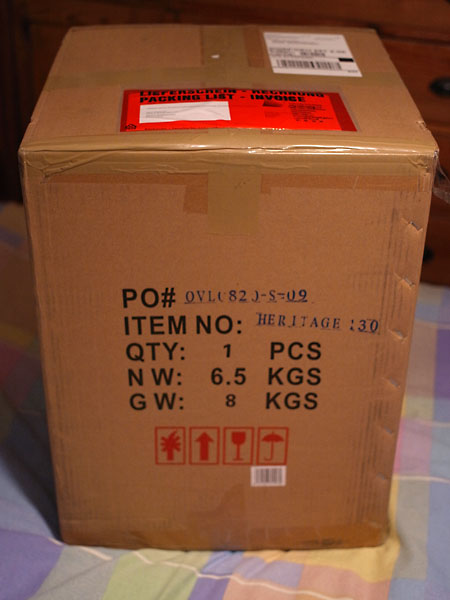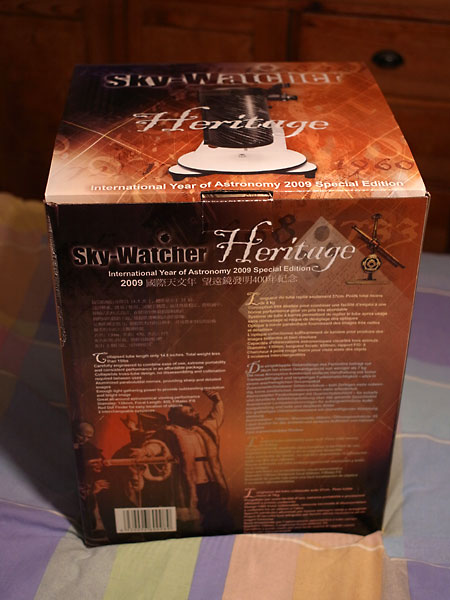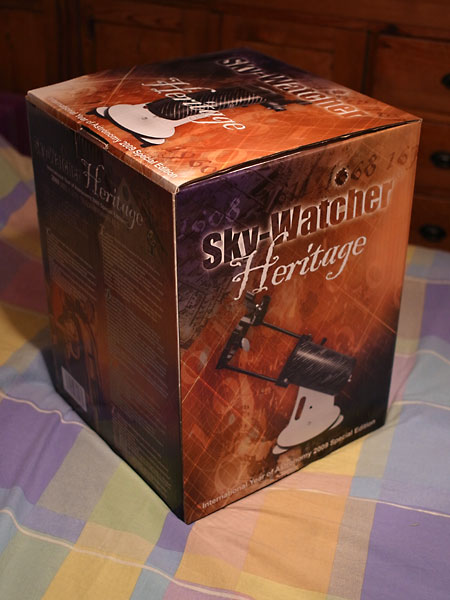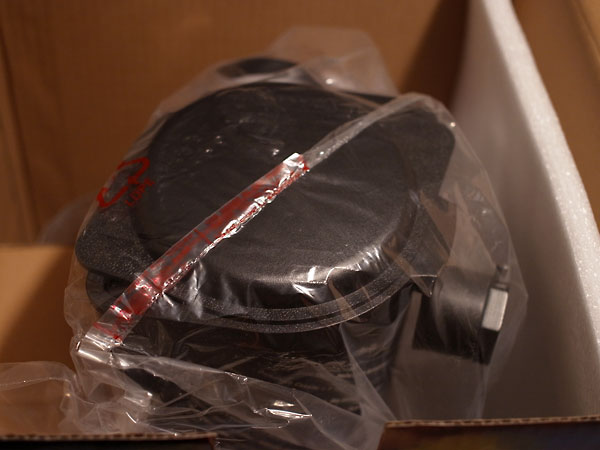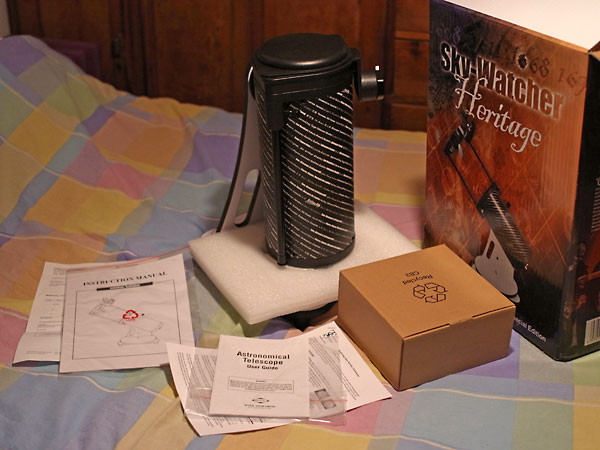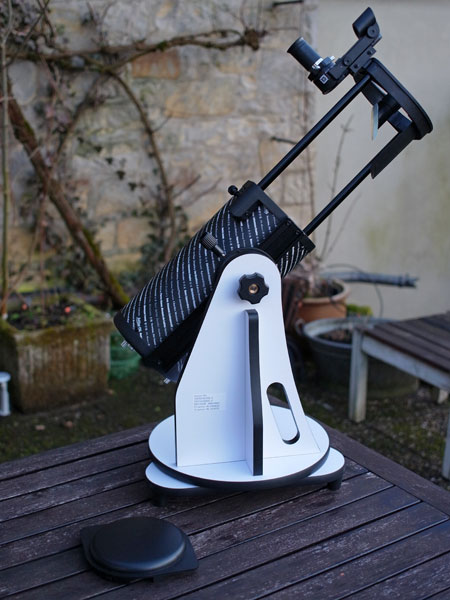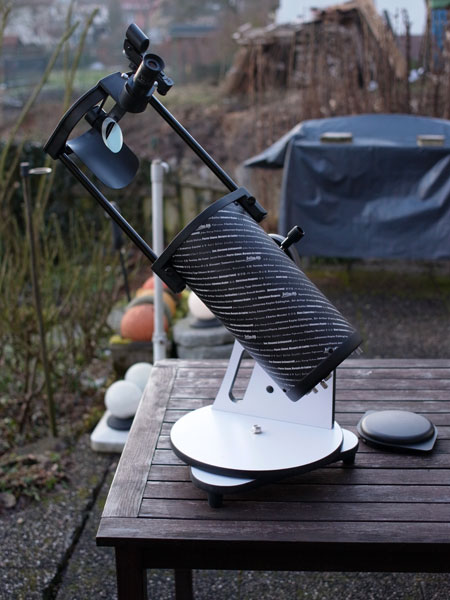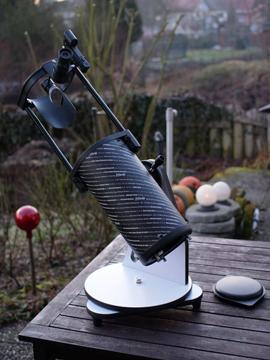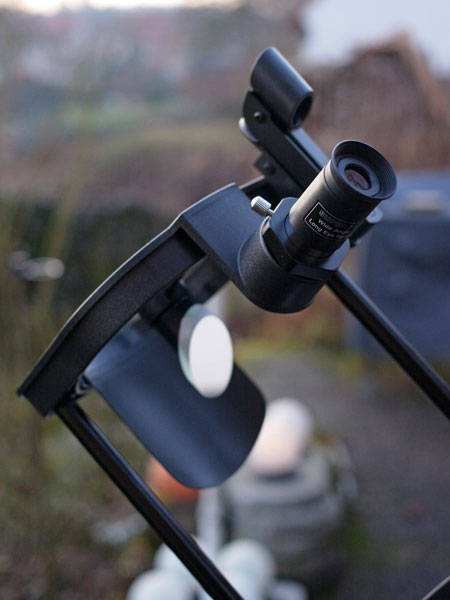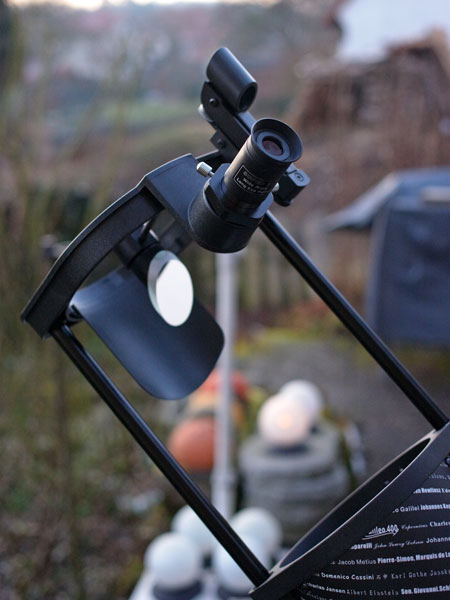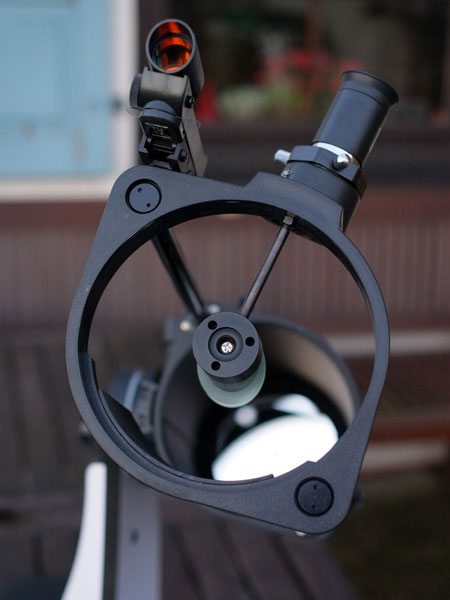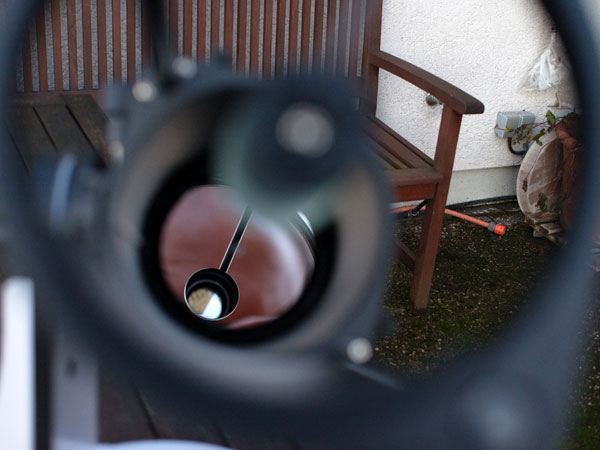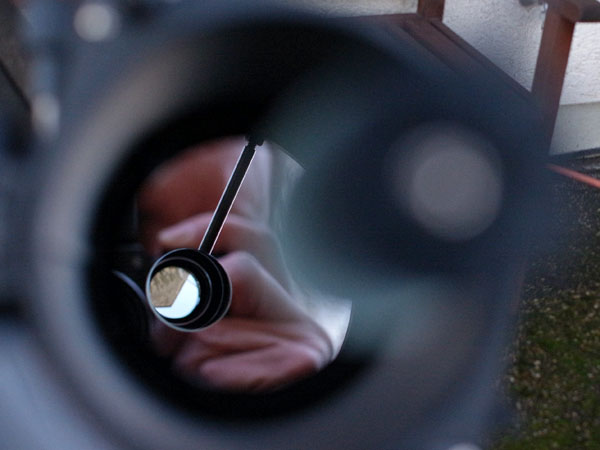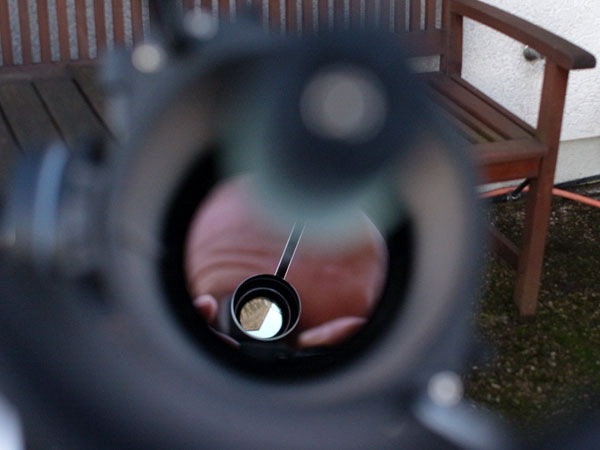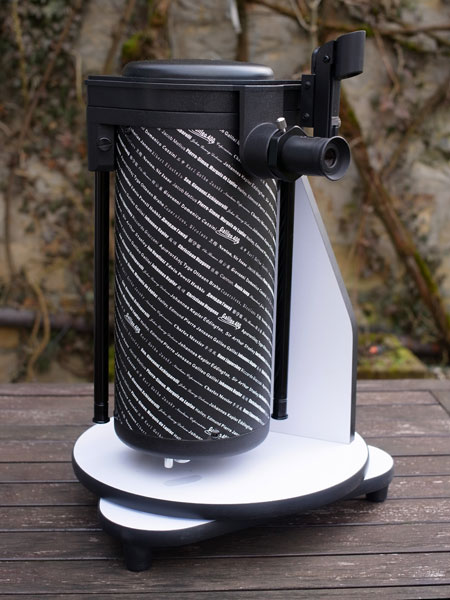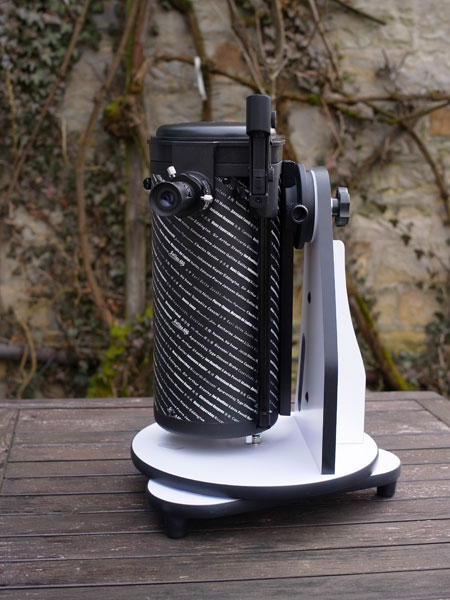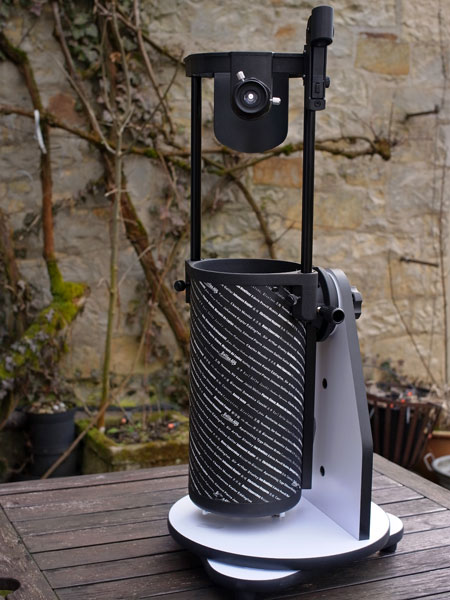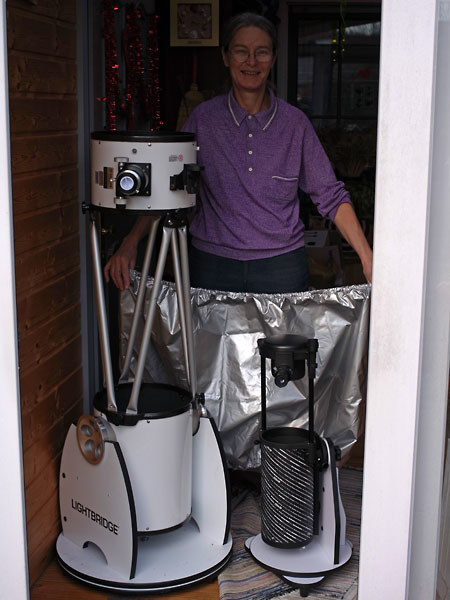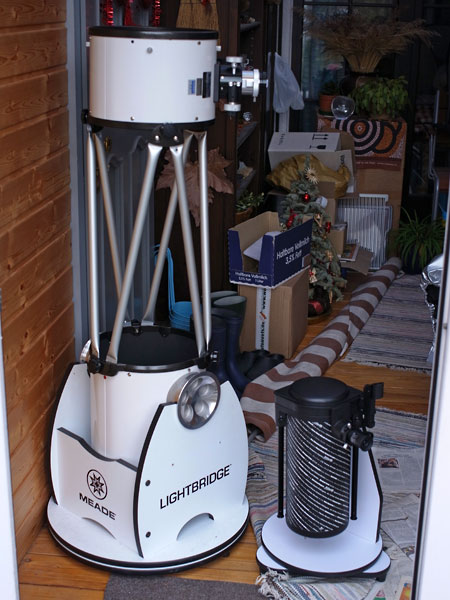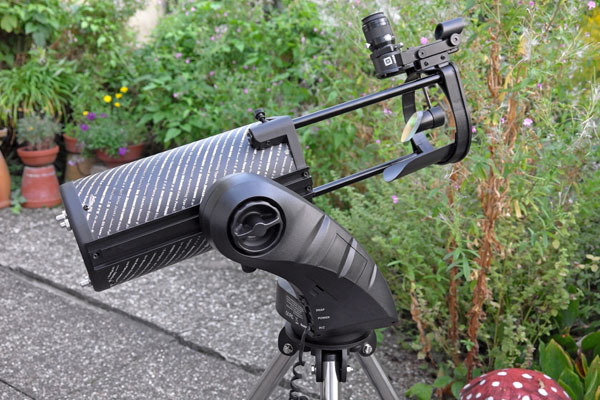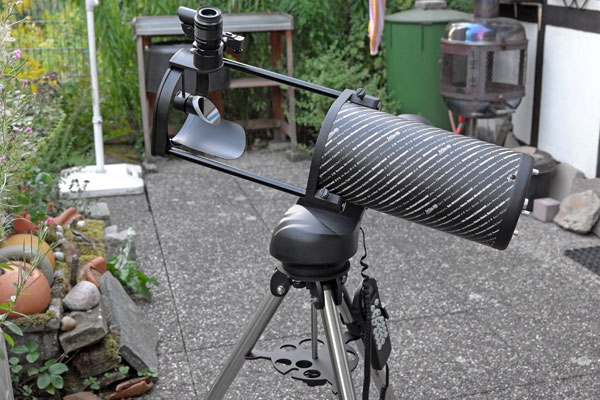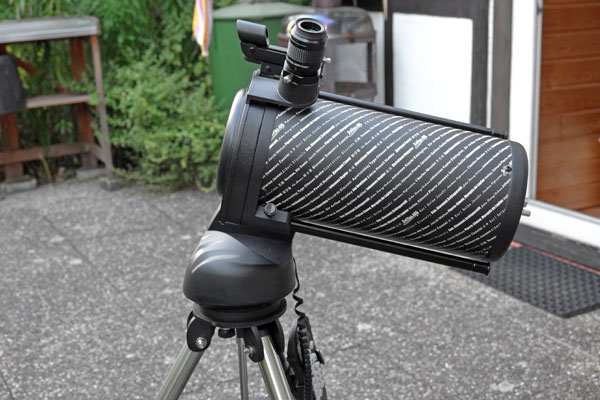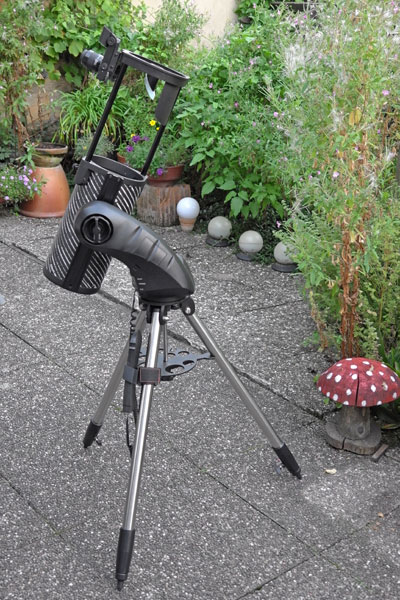Sky-Watcher Heritage P130 Information (5" Dobson)
Motivation | Look | Visited Sky Objects | Photo Attempts | Conclusions | What Others Say... | Links | Appendix: Data
Archive
On this page, I present some information about my first travel telescope (Dobson), a Sky-Watcher Dobson Telescope Heritage P130 FlexTube DOB, or Heritage P130 for short (purchased in February, 2010). In the end, it proved too big for travelling, but I still kept it for home use, either on its own base or on the Sky-Watcher Star Discovery AZ GoTo mount. See the appendix for the data.
| Note: Since I bought a 6" Newton tube in April 2017, the Heritage P130 had become somewhat redundant (see below), and I gave it away in mid-April 2017. I therefore can no longer report any experiences with this scope here. |
Motivation
Why did I buy the Sky-Watcher Heritage P130 telescope and for what purpose? In 2009, after 10 years of a mixture of joy and frustration, I bought a Meade 10" LightBridge truss Dobsonian telescope to get into astronomy more seriously. As beautiful as this telescope was, it was always a little tedious for me to set it up on our terrace, and it was not suitable for travel anyway. After some Internet research, I came up with the idea to add a small Dobsonian telescope, which is also suited to traveling. The Heritage P130 seemed ideal for this purpose, it was inexpensive too, and its sliding mechanism reminded me of a truss Dobsonian. This mechanism also made it quite compact when stowed away.
On the Internet, the Heritage P130 was rated quite well, although not by everyone. Primarily, its eyepiece holder gave rise to complaints, and I can only agree with that. Overall, I have observed a lot of sky objects with this telescope, especially after my entry into the world of deep sky objects in 2016.
The Heritage P130, however, turned out to be a bit too bulky for travel. So I soon bought a Heritage 76 for this purpose, and, because I was not satisfied with it, a Heritage 100P. It turned out that I often used the Heritage 100P instead of the P130 for quick observations... After purchasing a Star Discovery GoTo mount in 2016, I also used the P130 on this mount instead of its astonishingly shaky own Dobsonian base.
In spring 2016, I parted with the Meade 10" Lightbridge Dobsonian telescope, becaue it was too heavy for me, and replaced it with an 8" GSD680 from GSO. But soon I found this telescope too heavy for me as well, so that in spring 2017 I parted from it, too (my dealer sold it for me), and bought a Sky-Watcher Explorer 150PDS-Newtonian tube. Why do I write all this? Because with this step, the distance between my large and the P130 tube had decreased from originally 10" to 5" to 6" to 5". Thus, the P130 did not make much sense to me any more, especially since I had bought a small telescope for travel. And so I decided to give the P130, which I appreciated very much (except for the eyepiece mechanism...), to a friend. This unfortunately meant that the base that I had intended to use for my Maksutov tubes and maybe even for my Explorer tube was also gone, but that is another story...
Look
First Day: Unpacking and Assembling
|
Outer package |
Package of the Heritage P130 |
Package of the Heritage P130 |
|
Opened package |
Content of package, telescope collapsed |
Ditto |
|
Telescope assembled and at full length |
Accessories: 10mm and 25mm eyepieces; red dot finderscope |
Package Dimensions: Outer Package: Package: |
Second Day: Outside
On the Following Days...
|
Collapsed |
Collapsed |
Expanded |
|
Expanded and "in use" |
Comparison of my Dobsons (2010)
|
Meade Lightbridge 10" versus Skywatcher Heritage 130P |
Ditto |
Ditto |
Heritage P130 Telescope Tube on Sky-Watcher Star Discovery AZ GoTo Mount
The Heritage P130 tube weighs less than 4 kg and can therefore be used on the Star Discovery mount. Here are some photos:
|
P130 "compact" seen
from the side
|
P130 in "working mode" seen from the side |
Ditto, seen from the other side |
|
P130 "compact", seen from the other side |
P130 in "working mode", overview |
Ditto, seen from the other side |
Visited Sky Objects
I visited (and documented...) the following sky objects with the Sky-Watcher Heritage P130:
- Moon
- Venus (crescent), Jupiter (with moons), Saturn (with ring)
- With GoTo (spring 2017): M 1, M 31, M 35, M 36, M 37, M 38, M 42/43, M 44, M 45, M 78, Mel 25, M 41, M 81/82, NGC 2237/2244, NGC 2264, NGC 884/869
- With GoTo (autumn 2016): M 13, M 92, M 57, M 11, M 31
This list is probably incomplete, because I did not document my observations well. But, at least, it shows, which objects can be found with this telescope. In addition, this telescope should be able to access all those sky objects that I listed for my smaller telescopes.
Highlights
- Planets: Venus (crescent; Venus Crescent 2017), Jupiter (with moons), Saturn (with ring; Saturn 2010)
- DSO (globular cluster): M 13, M 92
- DSO (star cluster): M 35, M 44, M 45, NGC 884/869
- DSO (nebulae): M 42/43
Photo Attempts
First Photos with Camera held to the Eyepiece
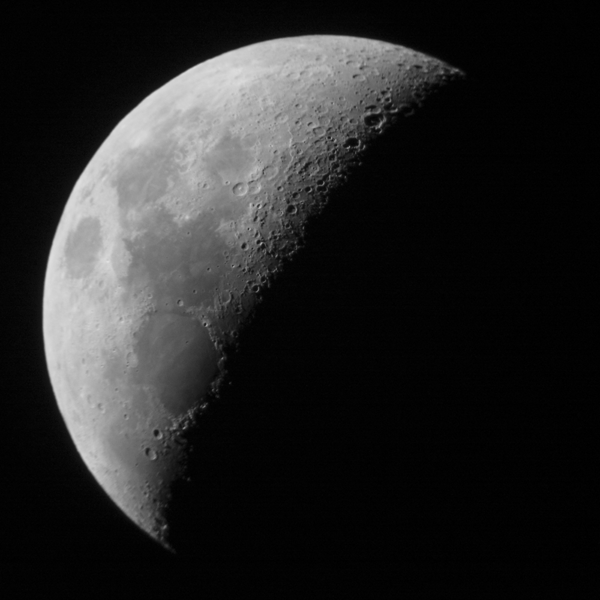 |
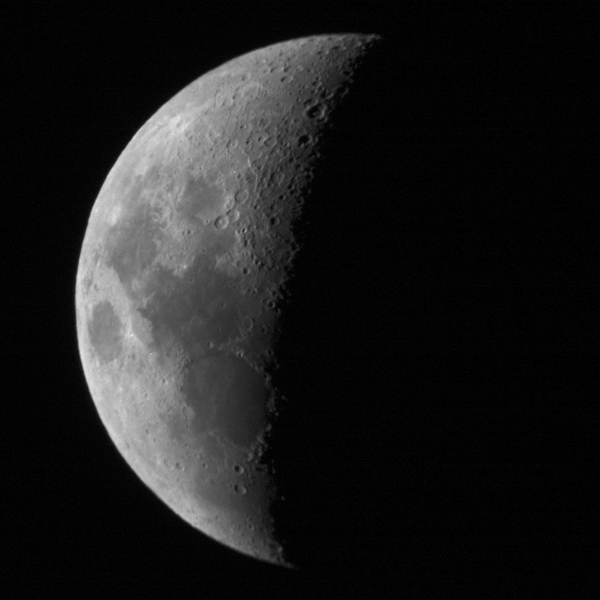 |
|
| My first, usable attempt (April 20, 2010) | My second, usable attempt from a series of similar shots (April 20, 2010) |
See more photos of the moon from April 2010
However, Saturn was too much for my camera (24.4.2010):


See more photos of Saturn from April 2010
Moon Photos 2016
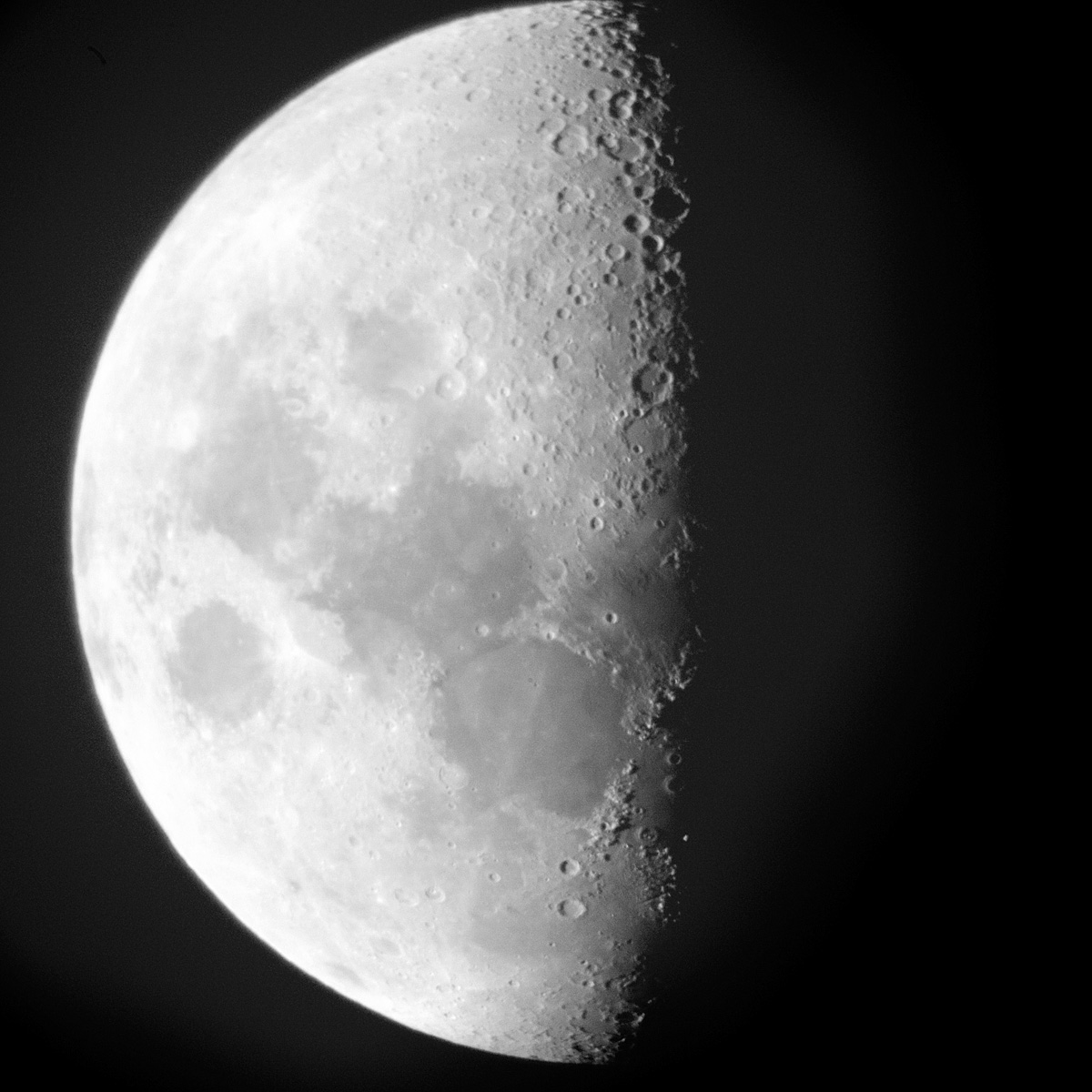 |
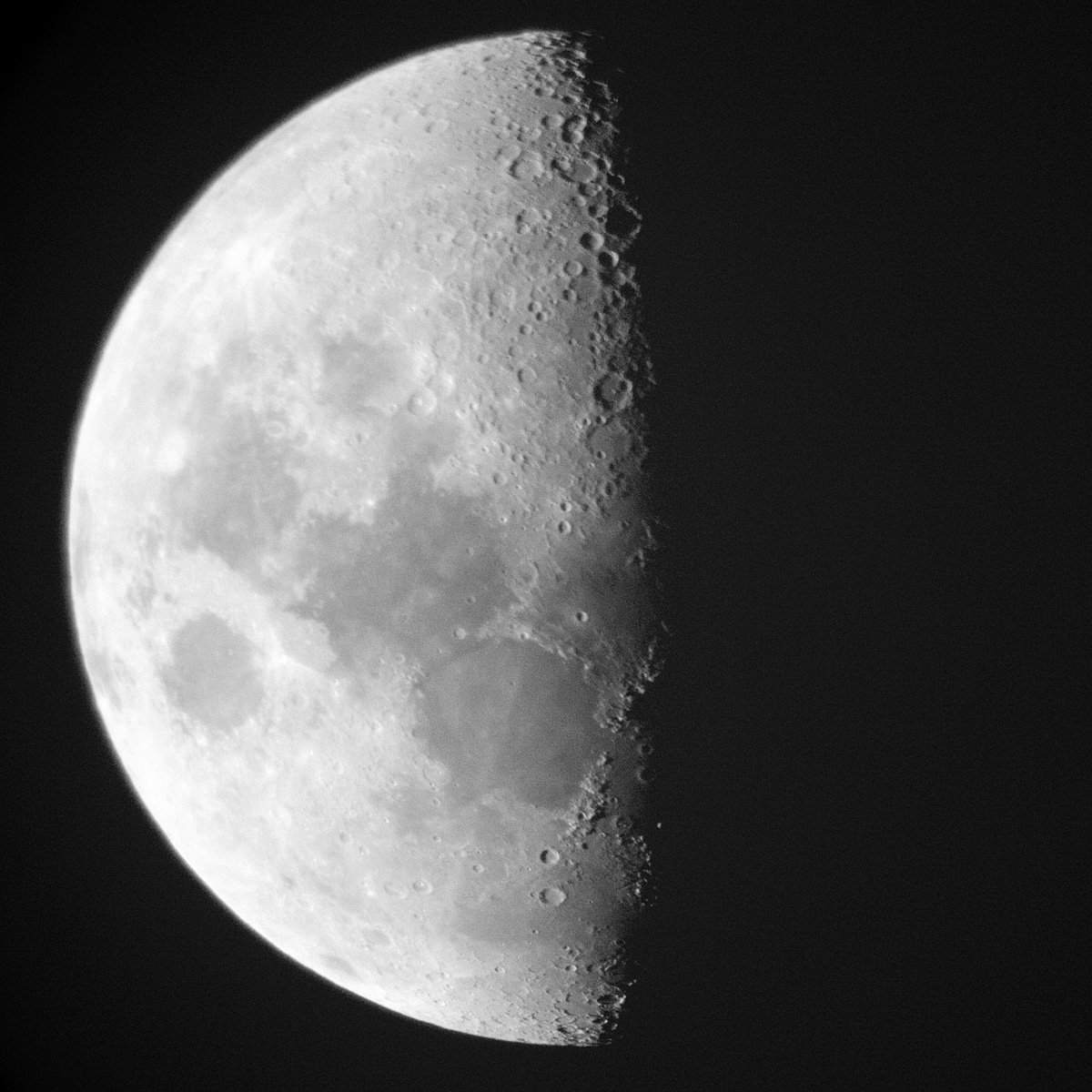 |
|
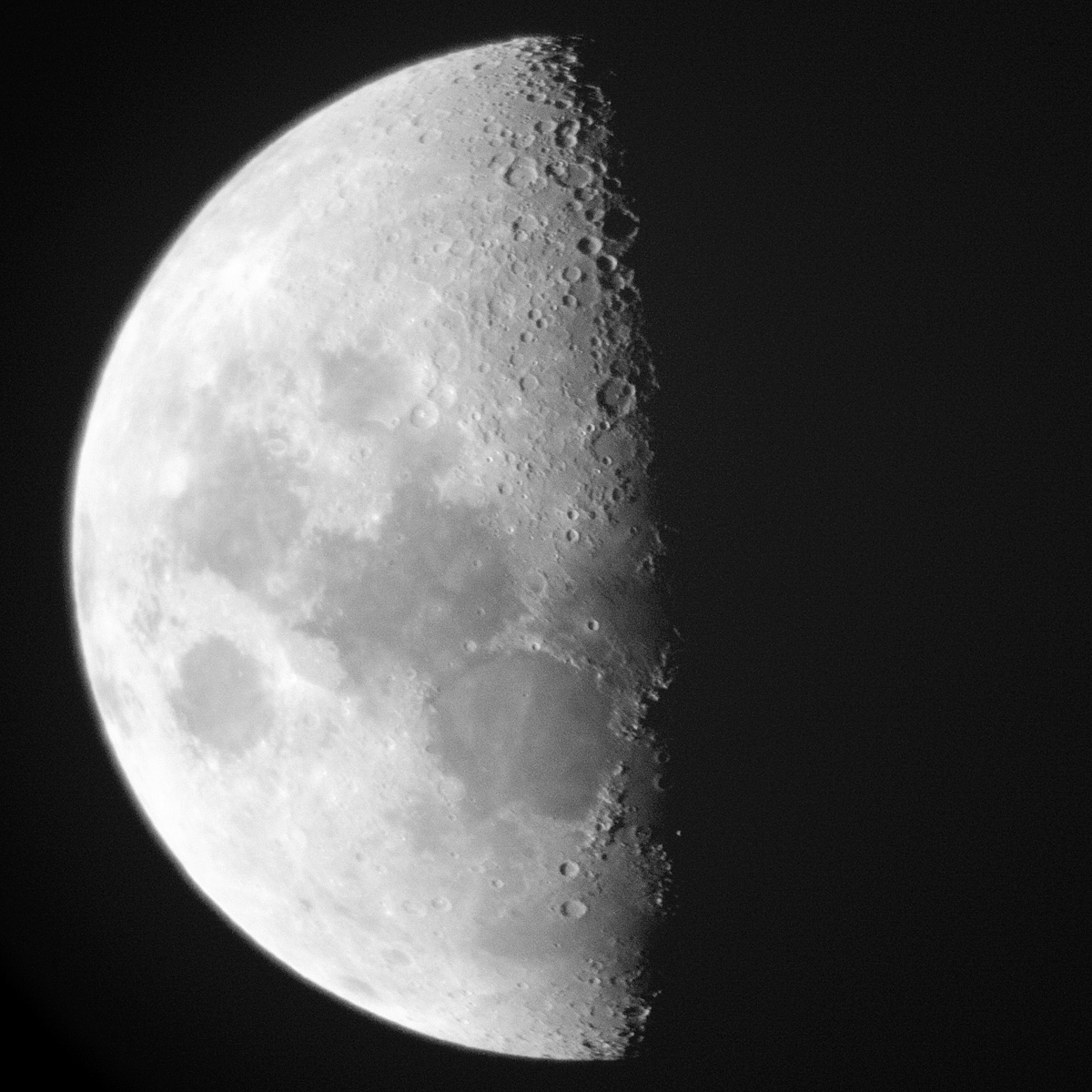 |
Photos with 16 mm wide-angle eyepice, Leica-M (Typ 240) with 50 mm lens held to the eyepiece (1:50 method) Photos taken on April 14, 2016 |
The following versions of the photos are the result of some post-processing to show more details in the lighter region of the moon:
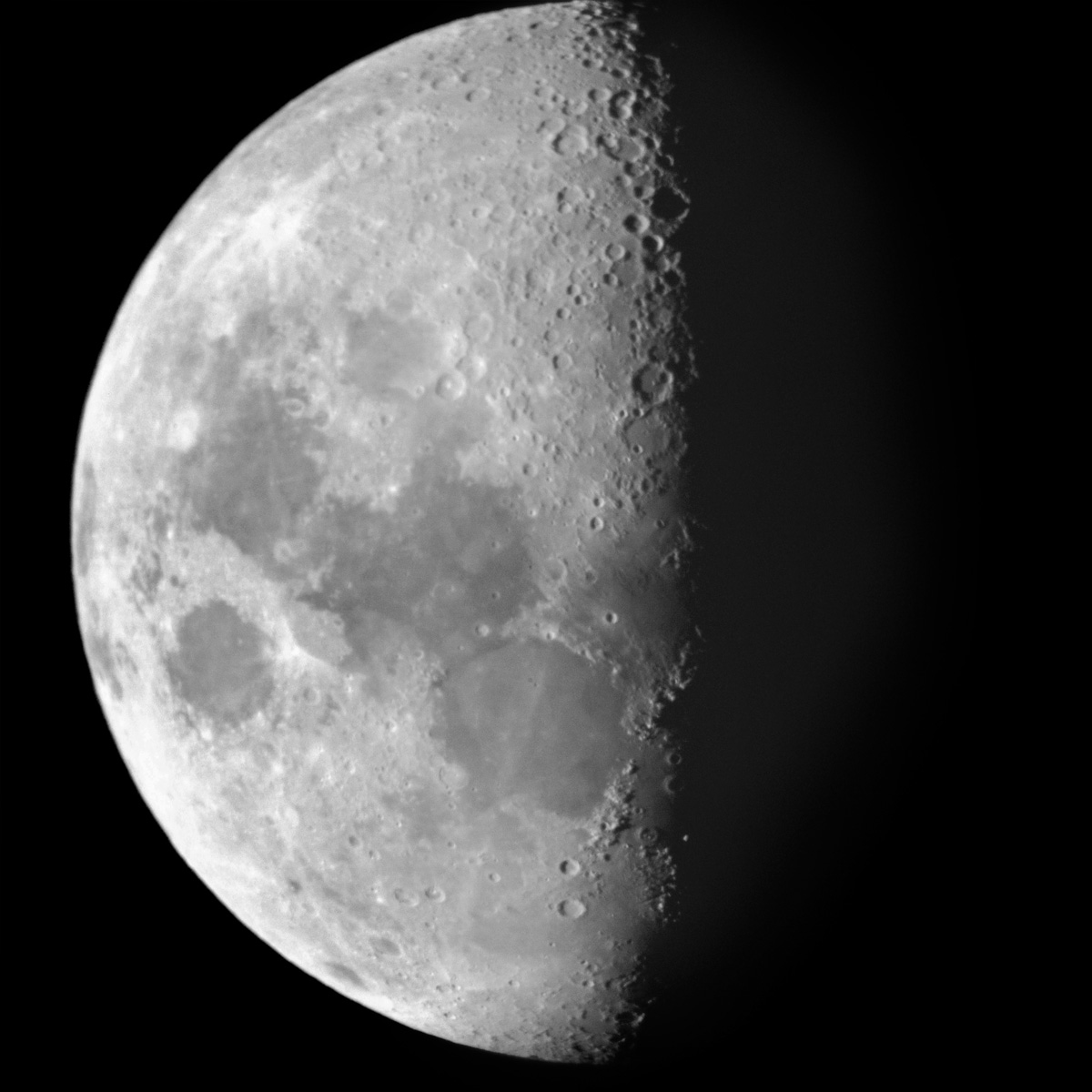 |
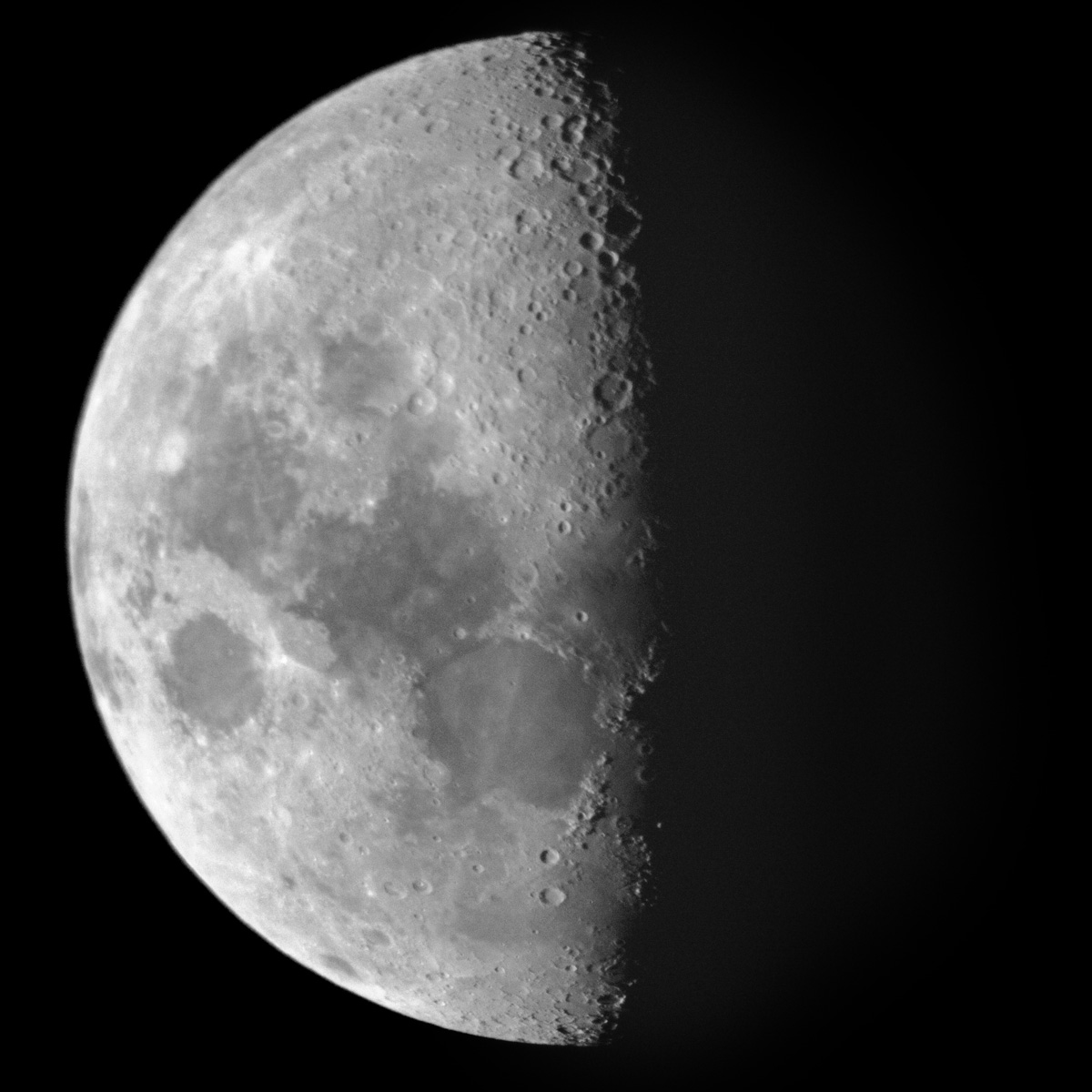 |
|
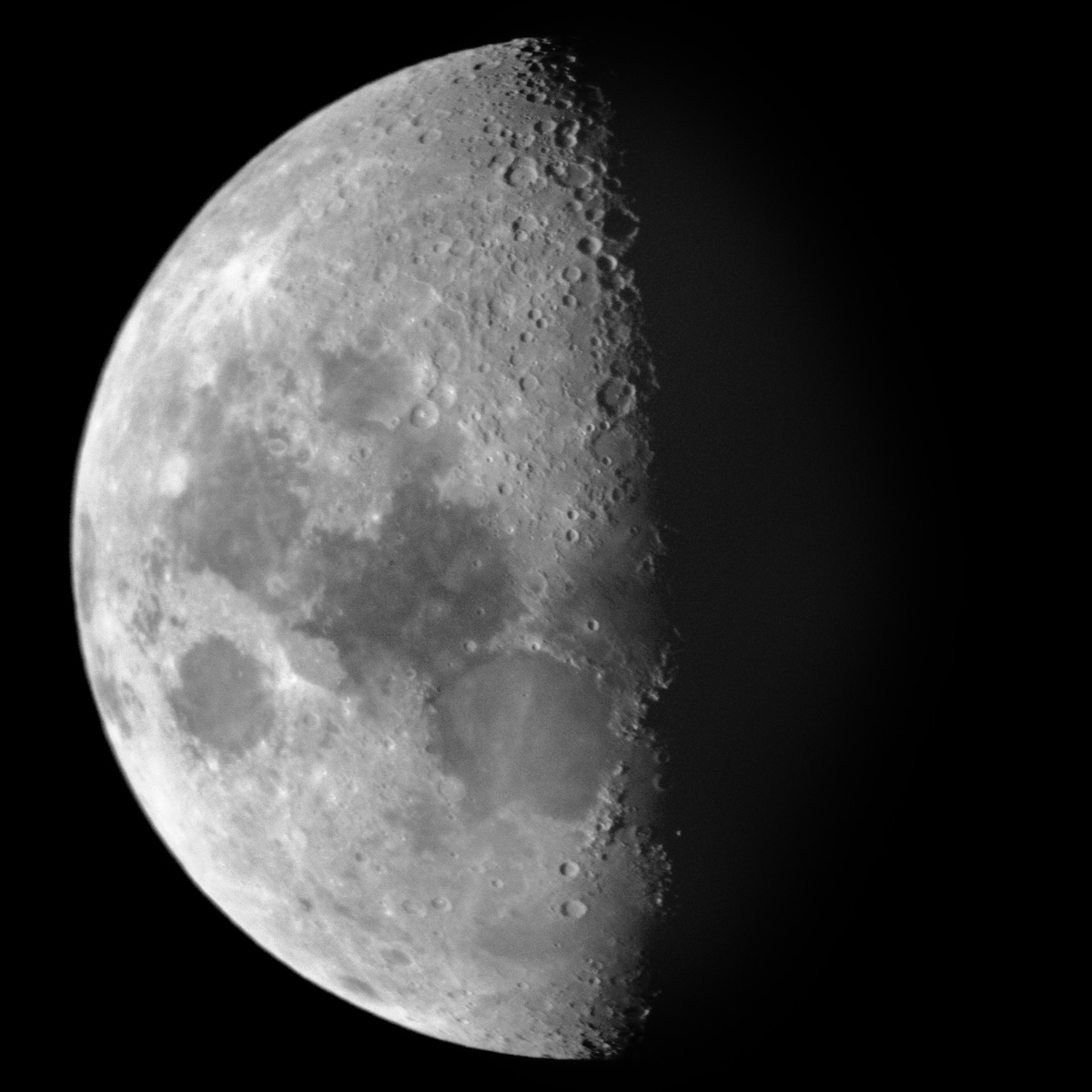 |
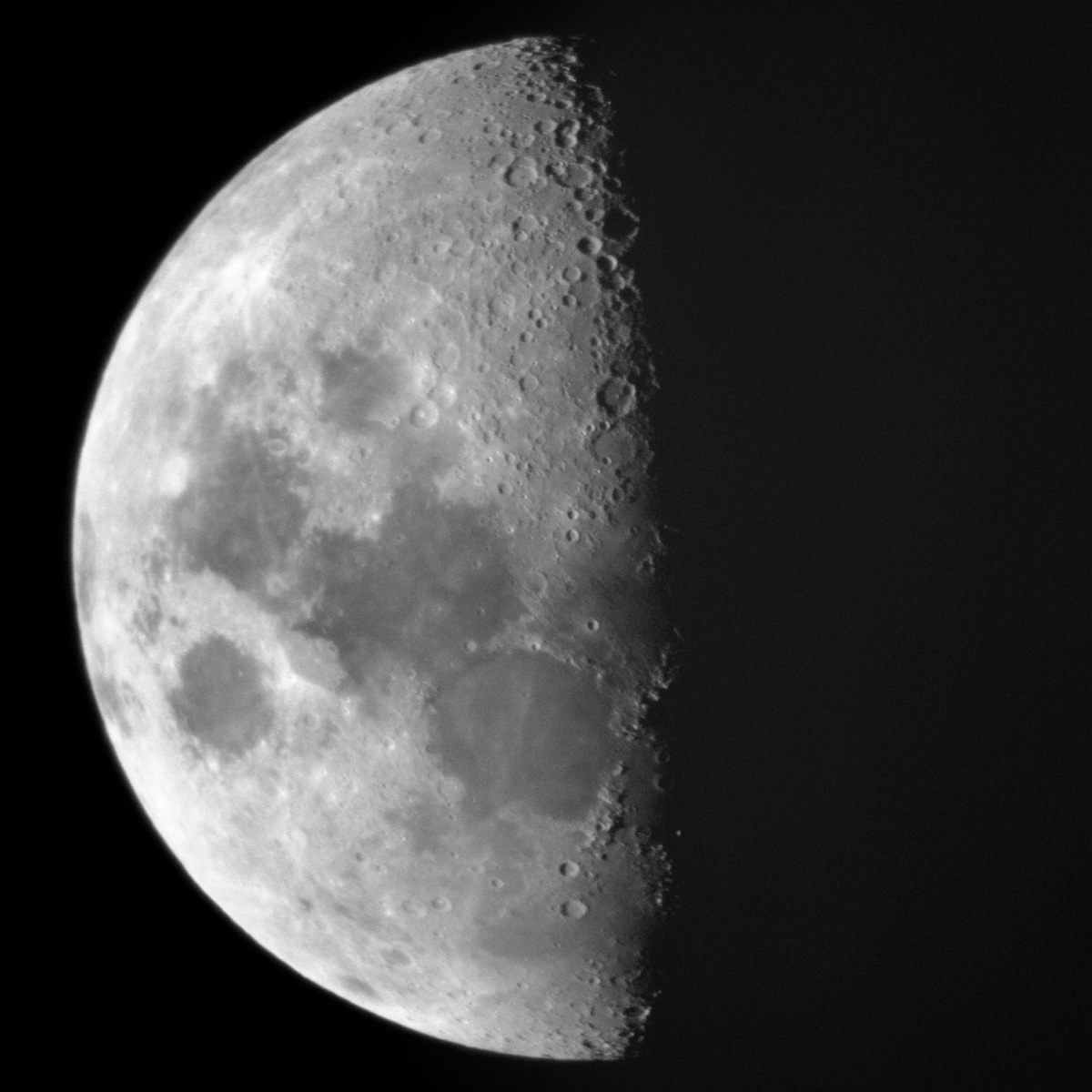 |
Bottom row: Two different attempts at the same photo...
Venus Crescent March 2017
On March 16, 2017, I observed the Venus crescent with my Sky-Watcher Heritage P130 (5") telescope, using a 16 mm and a 4 mm UWA eyepiece. The selected photos below are 100% crops. The photos were taken with a Ricoh GR (1:50 method).
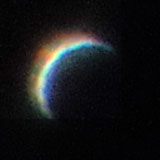 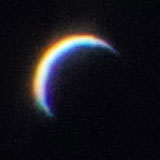 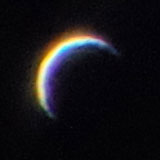 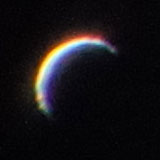 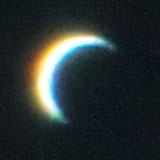 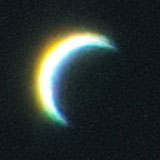 |
16 mm UWA eyepiece (about 40 x) |
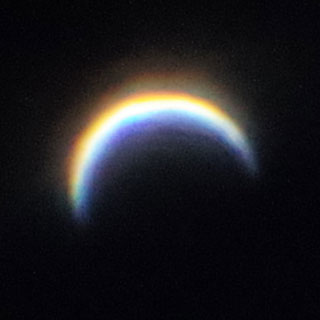 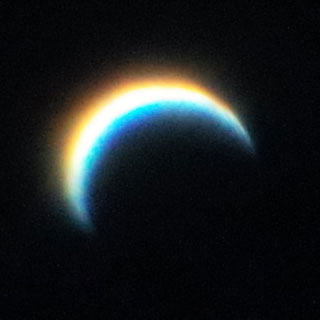 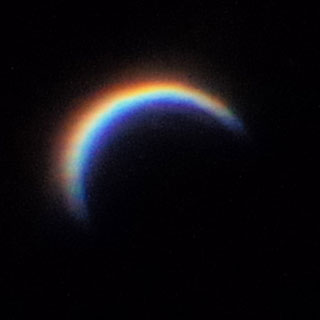 |
4 mm UWA eyepiece (about 160 x) |
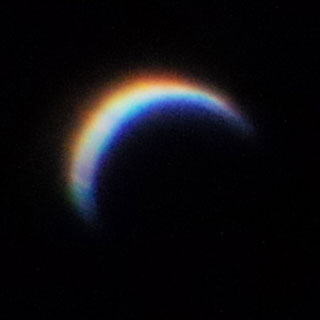 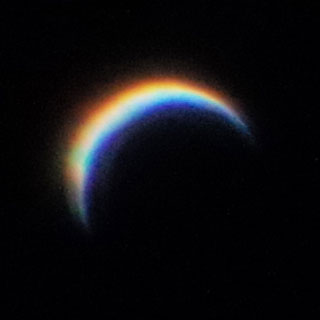 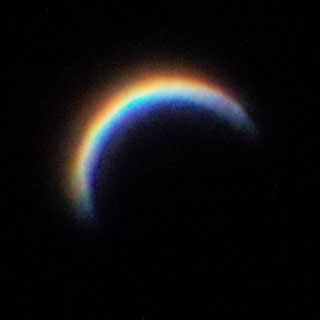 |
4 mm UWA eyepiece (about 160 x) |
Photos with Camera (Ricoh GXR) Mounted to the Eyepiece
See my photo attempts with the camera (Ricoh GXR) mounted to the eyepiece on pages:
Conclusions
My experiences with the Heritage P130 Dobsonian telescope (purchased in February,
2010, given away in mid-April 2017, see below) were very
satisfying. Photos of the moon were surprisingly sharp, and the planets Venus,
Jupiter, and Saturn could be identified well* by their details (crescent, stripes,
ring) (the Cassini division could not be identified, however; perhaps the air
turbulence was too high). Major deep sky objects were also nice to observe
in this relatively small telescope. Obviously, the parabolic mirror showed
its advantage. All in all, I was satisfied with the image quality of this low-cost
telescope.
*)This judgment refers to an "adjusted
state" as
well as to the state before my adjustment attempts in 2015.
Since I purchased the Sky-Watcher Star Discovery AZ GoTo Mount (July 2016), I was also able to use the tube as a GoTo telescope, especially for deep sky objects. I was able to observe a number of deep sky objects (summer/autumn 2016, spring 2017).
There were two things that I did not like about this telescope:
- The helical focuser was not very sensitive when adjusting sharpness
- The "shaky" suspension of the tube: The tremor was probably due to the unilateral suspension. Unlike the smaller Dobsons, the tube was already too heavy here for a unilateral suspension. Therefore, the telescope was trembling stronger than its smaller "mates."
Everytime I changed the focus and thus, rotated the eyepiece the view got into trembling. This was very disturbing for me. Unfortunately, it did not seem possible to replace the eyepiece with a better one. These two items were also addressed by other owners (see below).
The quality of the eyepieces is also judged very differently on the Internet. Most reviewers find the 25 mm eyepiece (a Kellner-type eyepiece) acceptable. On the other hand, I found strong red color fringes when using it (in daylight). Others think that the 10 mm eyepiece is very poor. I found that it has at least less fringing. Since I bought additional, better eyepieces, the quality of the kit eyepiece was not important to me. It would probably make more sense if they would deliver them without eyepieces - or with better ones.
Comparison with Sky-Watcher Heritage 100P (Dobson)
Compared with the Heritage 100P, this scope is definitely bulkier, heavier and not as easy to use - although as a table-top Dobsonian it is still easy to use. But it takes more effort to take it out on the terrace or balcony and start observing. I also did not take this scope with me on vacations (only to friends, relatives, or where we do not sleep in our car). The mount exhibited more shivering, probably because of the higher weight on a one-arm mount.
Quality-wise, the P130 clearly has the lead and magnifies about 1.5 x more than the 100P, given the same focal length of the eyepiece. The same accounts for the different types of maximum magnification (see Basic Data). It can also be collimated (adjusted) correctly, whereas on the 100P only the secondary mirror can be adjusted. Nonetheless, since the 100P can be grasped and used quickly and easily, it was significantly more often in use than the P130.
Comparison with Sky-Watcher Skymax-102 OTA (Maksutov-Cassegrain)
In the summer of 2016, I bought a Sky-Watcher Skymax-102 OTA (a tube only) because a dealer persuaded me to do so. It is a Maksutov-Cassegrain telescope with approximately the same opening as the Heritage 100P (the Skymax-127 would be a direct companion), but twice the focal length, and thus, you get twice the magnification for the same eyepiece. At maximum, the P130 gets a little bit higher: 220 x (factor 1.5) or 260 x (factor 2) versus 204 x (factor 2).
With my existing eyepieces, the Heritage P130 reaches a magnification of 162.5 x (4 mm eyepiece) and the Skymax-102 reaches 186 x (7 mm eyepiece), with respect to the beneficial magnification. The Skymax-102 can exceed the beneficial magnification: the 6 mm eyepiece reaches already 217 x. But for certain deep sky objects you might, according to Stoyan, even go to 300 x, provided the seeing permits this. The 4 mm eyepiece reaches a magnification of 325 x for the 102, but then the image is, for my taste, no longer good...
The Heritage P130, like the 100P, has the advantages of a wide field of view and a "faster" focal ratio (f/5 versus f/12.75) over the Skymax-102. Such a "fast" focal ratio puts higher demands on the eyepieces, but later I had some better eyepieces in my collection... Thus, in this respect, the P130 should be more suitable for deep sky observations, in particular, for more extended objects, than the Slymax-102. I h used the P130, more or less successfully, for this purpose, but a direct comparison with the Skymax-102 on the same sky objects is missing and can no longer be done. I cannot say anything about the deep sky abilities of the Skymax-102, whereas I was disappointed by those of the Meade ETX 90/EC (I was barely able to see the Andromeda galaxy, but this may also have been due to the observation conditions...).
A comparison of the image quality at day-time and at night between the Heritage P130 and the Skymax-102 was on my waiting list - and this will remain so, because I gave the P130 away in mid-April 2017 (see below)...
Comparison with Sky-Watcher Explorer 150PDS (Newton)
In early April 2017, I bought a 6" Newton tube, a Sky-Watcher Explorer 150PDS 150 mm / 750 mm (f/5), as a replacement for my 8" GSD 680 Dobsonian telescope, which had become too heavy for me, and it made a good first impression on me. I would also like to to use it on the Sky-Watcher Star Discovery AZ GoTo mount, which is not possible with the 8" GSD 680. A first test revealed that this seems to be a "borderline case " - I do not know whether the engine and the gearbox will last long under this heavy load. But it seems to work at the moment...
About a week later (April 9, 2017), I performed a simple comparison of the Heritage P130 and the 6" Explorer 150PDS using the targets M 42/43 and M 35. Since I was not able to operate the telescopes in parallel at exactly the same magnification, such a comparison is, of course, problematic. Overall and hardly surprising, the view was somewhat better in the 150PDS than in the P130, although I would not say that the differences were huge.
Final Words...
Considering the results of the comparison with the Explorer 150PDS, I could not see any advantages in owning both telescopes, since they are fairly similar optically, although the P130 is certainly better suited to traveling. So I gave the 5" Heritage P130 away, as nice as it was, in mid-April 2017.
What Others Say...
A Brief Review and First Conclusions
Skywatcher Heritage 130P Flextube Dobsonian (Dodge, Stargazers Lounge, 2011-08-18): stargazerslounge.com/topic/113026-skywatcher-heritage-130p-flextube-dobsonian
This is a nice review of the Heritage P130, from which would like to cite a few remarks:
- First light was mid-June, so it was a late one! I'm fortunate enough to have some farily dark skies where I live which is a bonus, but my first target (of course) was Saturn. To be honest, I was gobsmacked when I pointed the RDF at the planet, and looked through the 25mm lens. I could clearly see the shape of Saturn which I was very surprised at. Using the 10mm and things became even more amazing - the rings were very clear. No Cassini division or shadow, but I could see the gap between the rings and the planet, and a moon (Titan). I was jumping up and down with excitement. Not bad for 65x mag!
- M13 was also high in the sky, and was easily visible yet mainly an unremarkable smudge - ditto M31. I think darker Winter skies will help before I pass judgement on the DSO performance.
- Later viewings allowed me to observe the moon which was utterly fabulous - it was VERY bright and clear, both with and without the Barlow. Drifting up and down the terminator showed a wealth of detail.
- Last night was a big night, the moon was fantastic as usual, and I managed to observe Uranus which was a surprise. I double and triple checked it with Stellarium and it could only have been the planet. With averted vision, I thought I could detect a moon close by - on checking when I'd packed down, Stellarium confirmed Oberon was where I thought I'd could see the moon. That was very surprising, as I didn't think I could see that far with such a small scope.
- Anyway, it finally happened - and Jupiter was visible for the first time. With the 25mm eyepiece it was piercingly bright, 4 moons easily visible and two bands on the planet surface. With the 10mm EP it was even more amazing. Unfortunately, the Barlow pushed the view beyond what the seeing allowed and I couldn't get a decent focus.
- To summarise:
Pros - Size, ease of assembly, portability, quality of 5" parabolic mirror, 25 mm EP not bad, cost.
Cons - Helical focuser not the most accurate, 10 mm EP a bit average, wobbles every time you touch it.
Someone else in the thread (nick-named "Astronomical") suggested using Teflon tape for making focusing smoother. This seeemed to work for other posters.
My Comment: In my opinion, the poster pointed exactly to the shortcomings of the telescope: the inaccurate focuser and the wobbling (or trembling) of the telescope each time you touch it, which can be very disturbing. The poor 10 mm eyepiece can be easily replaced with a better one...
Why Isn't the Skywatcher Heritage 130p Ideal for Astrophotography?
There is a thread in astronomyforum.net (requires registration) asking the question above. Here are the answers that "Super Moderator" KeithBC provided:
There are several reasons why it is not suitable for astrophotography:
- A Dobsonian mount (any alt-az mount, really) limits you to 30 seconds maximum exposure due to field rotation.
- It does not have tracking motors, which further limits you to less than 1 second exposure time.
- Newtonians are not generally able to focus a DSLR camera.
You can do planetary astrophotography (AP) without a tracking mount, though tracking will considerably improve the convenience. Planetary AP is usually done using video, at fast frame rates. You would be able to shoot a few seconds of video before the scope has to be repositioned.
You absolutely need tracking for imaging deep space objects, though. A tracking alt-az mount will allow exposures up to 30 seconds. To go beyond 30 seconds, you need a tracking equatorial mount. Deep space objects benefit from exposures that are several minutes long.
Links
- Sky-Watcher Company Website, USA: www.skywatchertelescope.net, ca.skywatcher.com (older
site?)
Heritage P130 page on Sky-Watcher Website: www.skywatchertelescope.net/product.php?cat=6&id=57, ca.skywatcher.com/_english/01_products/02_detail.php?sid=363 - Pages from German Distributors for the Sky-Watcher Heritage P130:
- zu-den-sternen: www.zudensternen.de/Teleskope%20f%FCr%20Kinder%20Dobson.html
- Astroshop: www.astroshop.de/skywatcher-dobson-teleskop-n-130-650-heritage-flextube-dob/p,14966 (in German) - www.astroshop.eu/skywatcher-dobson-telescope-n-130-650-heritage-flextube-dob/p,14966 (in English)
- Teleskop Service (here, I bought the telescope): www.teleskop-express.de/shop/product_info.php/language/de/info/p2705_Skywatcher-Heritage-130P-FlexTube-Dobson---6years--.html (in German) - www.teleskop-express.de/shop/product_info.php/language/en/info/p2705_Skywatcher-Heritage-130P-FlexTube-Dobson---6years--.html (in English)
- Teleskop-Spezialisten: www.teleskop-spezialisten.de/shop/Teleskope-fuer-Einsteiger-Kinder-und-als-Geschenk/Skywatcher-Heritage-130P-130-650-Newton-FlexTube-Dobson-Teleskop-mit-Zubehoer::356.html (in German) - www.teleskop-spezialisten.de/shop/Telescopes-for-beginners-children-and-as-a-gift/SkyWatcher-HERITAGE-130P-FLEXTUBE-Newtonian-Dobsonian-Telescope::356.html?language=en (in English)
- Discussions:
- Stargazing: My first telescope (Roy van Rijn): www.royvanrijn.com/blog/2014/01/stargazing-my-first-telescope
- Stargazers Lounge: Skywatcher Heritage 130P Flextube Dobsonian (Dodge): stargazerslounge.com/topic/113026-skywatcher-heritage-130p-flextube-dobsonian
- Stargazers Lounge: Choosing the first telescope: Heritage 130 or Virtuoso (Trillian): stargazerslounge.com/topic/217446-choosing-the-first-telescope-heritage-130-or-virtuoso/?page=1 (two pages)
- Stargazers Lounge: Home made Heritage 130p ligght shroud (HappyKat): stargazerslounge.com/topic/203730-home-made-heritage-130p-ligght-shroud
- Stargazers Lounge: Thoughts on a Heritage 130p Light Shroud (AndyWB): stargazerslounge.com/topic/188929-thoughts-on-a-heritage-130p-light-shroud/
- astronomyforum.net: Why Isn't the Skywatcher Heritage 130p Ideal for Astrophotography? (mgb186): www.astronomyforum.net/astronomy-beginners-forum/180569-q-why-isnt-skywatcher-heritage-130p-ideal-astrophotography.html
- Neil English.net: A Newtonian Travel ‘Scope (Neil English): neilenglish.net/a-newtonian-travel-scope
- Telescope Reviews UK: The Sky Watcher Heritage 130 FlexTube Dobsonian telescope (Ralph Bell): telescopereviewsuk.wordpress.com/2009/10/28/the-sky-watcher-heritage-130-flextube-dobsonian-telescope
- Astrotreff-Deep-Sky: Mondphasen- und Reiseteleskop gesucht (derp): www.astrotreff-deep-sky.de/ATDS_postst8953_Mondphasen-und-Reiseteleskop-gesucht.aspx (in German)
- Astotreff: Skywatcher Heritage 130P Flextube Testbericht (Stathis): www.astrotreff.de/topic.asp?ARCHIVE=true&TOPIC_ID=102171 (in German)
- See also my page offering Astronomy Links.
Appendix: Data for Sky-Watcher Dobson Telescope Heritage P130 FlexTube DOB
| Telescope: Sky-Watcher | Heritage P130 |
| Optical Design | Newton (Parabolic) |
| Primary Mirror Diameter | 130 mm (5") |
| Focal Length, Focal Ratio | 650 mm, f/5 |
| Resolving Power (arc secs) | 0.9" |
| Limiting Visual Stellar Magnitude | 13.3 mag |
| Light Gathering Power | 344.9 |
| Maximum Practical Visual Power | ca. 195/220 x (260 x) |
| Optical Tube Dimensions (diam. x length) | Tube collapsed < 37 cm (14.5") long |
| Net Weight Basis | 3.1 kg* |
| Net Weight Optical Tube | 3.25 kg* |
| Net Weight Complete | < 6.5 kg or 14 lbs. |
Dark Blue: Telescopes that I still own; italic and dark red: telescopes that I owned; black: for comparison; *) own measurement; corrected values
See also the table of data for all of my telescopes (and a few more...)
Observation-Relevant Data (in Comparison with other Newtonian Tubes)
| Telescope | Focal |
Aperture (mm) |
Focal Ratio |
Light Gathering Power |
Maximum+ |
Minimum* |
Maximum* |
Minimum+ |
|||||
Usable Magnification |
Usable Focal
Length of Eyepiece (mm) |
||||||||||||
Factor/Exit Pupil (mm) > |
Manuf. |
1.5 |
2 |
6.5 |
7 |
6.5 |
7 |
1.5 |
2 |
||||
| Dobson/Newton 10" | 1270 |
254 |
5 |
1317 |
600 |
381 |
500 |
39.08 |
36.29 |
32.5 |
35.0 |
3.3 |
2.5 |
| Explorer 150PDS/Dobson 6" | 750 |
150 |
5 |
459 |
225 |
300 |
23.08 |
21.43 |
32.5 |
35.0 |
3.3 |
2.5 |
|
| Heritage P130 | 650 |
130 |
5 |
345 |
220 |
195 |
260 |
20.00 |
18.57 |
32.5 |
35.0 |
3.3 |
2.5 |
| Heritage 100P | 400 |
100 |
4 |
204 |
150 |
200 |
15.38 |
14.29 |
26.0 |
28.0 |
2.0 |
2.7 |
|
*) Calculated for an exit pupil of 6.5 mm and 7 mm
+) Factor 1.5 or 2 for Dobsonian/Newtonian telescopes; in general, the lower
value of 1.5 is used for Newtonian telescopes; if the manufacturer specified
a different magnification, it is also listed (some manufacturer provide considerably
higher numbers...).
Recommendations for the Focal Lengths of Eyepieces for Heritage P130 (Following My Recommendations and Those of Others)
| Criteria | Exit Pupil |
Focal
Length of Eyepiece |
|||||
| Category | Application Area | from...to |
Calculated |
On the Market |
Examples |
Proposals |
|
| Maximum FOV | Search | 7 |
10 |
35-50** |
32-40 |
32, 40 |
32 |
| Minimum Magnification / Large FOV | Overview, large-area nebulae | 4.5 |
6.5 |
22.5-32.5 |
22.5-32 |
20, 25, 26, 32 |
25 |
| Normal Magnification | Large-area, faint nebulae; nebulae, open star clusters | 3.5 |
4 |
17.5-20 |
18-20 |
18, 20 |
18 oder 20 |
| Best for many objects, e.g. for most galaxies, and mid-size DSO | 2 |
3 |
10-15 |
10-15 |
10, 12, 15 |
10, 15 |
|
| Maximum Magnification / Maximum Resolution | "Normal" upper magnification limit; globular star clusters | 1 |
1.5 |
5-7.5 |
7-7.5 |
5, 6, 7 |
5, 7 |
| Maximum perceptibility of small, low-contrast
details; planetary nebulae, small galaxies; maximum magnification for moon and planets |
0.6 |
0.8 |
3-4 |
3-4 |
3, 3.5, 4 |
4 |
|
| Separation of narrow double stars, small planetary
nebulae; perception of faintest details |
0.4 |
0.5 |
2-2.5 |
2-2.5 |
2, 2.5 |
2.5 |
|
**) Typically no suitable 1,25" eyepieces available; problems with viewing at 40 mm; italic: not possible; red: magnification too high; blue: commercial focal lengths
| 21.11.2024 |
